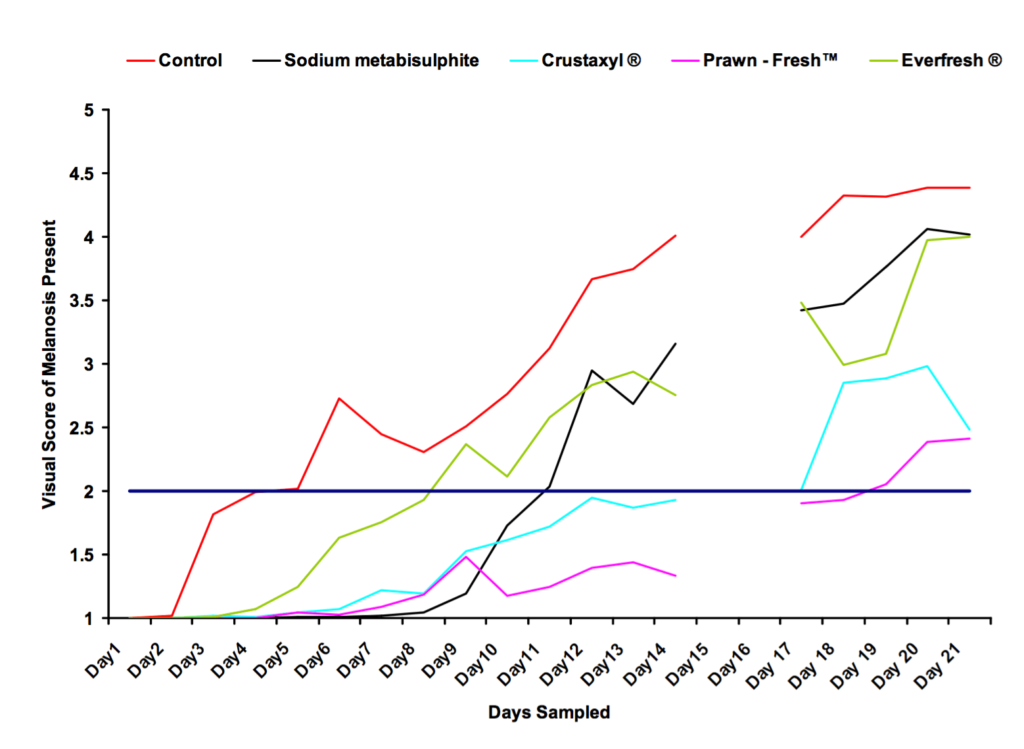Bord Iascaigh Mhara (BIM) Killybegs, Ireland
Untreated prawns can develop an unsightly, but harmless condition called black-spot, or melanosis, which can render the product unsaleable. Traditionally this has been controlled by dipping whole prawns in a solution of sodium metabisulphite. Recent EU allergen labelling requirements have prompted buyers wishing to promote an ‘additive free’ product, to source non-sulphite treated prawns. Several products are now commercially available, which manufacturers claim are safe and effective alternatives to dipping with sodium metabisulphite.
To assist industry establish viable alternatives, Bord Iascaigh Mhara (BIM) carried out trials in June 2008 to compare the effectiveness of four commercially available products; sodium metabisulphite (4% concentration), and three non-sulphite based products; Crustaxyl®, Xyrex® Prawn-FreshTM and Everfresh®. Batches of freshly trawled prawns were treated according to manufacturers’ instructions, stored under chilled conditions and monitored daily for the development of melanosis over the course of trials, using the following criteria:
| Stage of melanosis | Score |
|---|---|
| None (no melanosis) | 1 |
| Slight (occasional black / grey) | 2 |
| Mild (some blackening) | 3 |
| Severe (mostly blackened) | 4 |
| Extreme (all / very black) | 5 |
Observations
The daily progression of melanosis, for each of the treatments, is outlined in Figure 1. The horizontal blue line denotes the point, above which prawns are deemed unacceptable to the Irish industry.
Prawns treated with Everfresh® showed the first signs of melanosis on day 4, which developed to an unacceptable level by day 8.
Melanosis was evident from day 6 in prawns treated with either Crustaxyl® or Xyrex® Prawn- FreshTM. These samples remained acceptable until day 17 and 18 respectively.
Treatment with Sodium Metabisulphite (4%) delayed the onset of melanosis to day 8. Once this point was reached, however, melanosis developed more rapidly than in Crustaxyl® and Xyrex® Prawn-FreshTM treatments, reaching an unacceptable level by day 11.
Figure 1. The development of melanosis over a period of 21 days in prawns in an untreated, Control, sample and samples treated with the recommended commercial concentrations of Sodium metabisulphite, Crustaxyl®, Xyrex® Prawn-FreshTMand Everfresh® (No data were available for day 15 and day 16 as sampling did not take place during this period).
Prawns treated using non-sulphite treatments developed a level of melanosis, unacceptable to industry, after the following periods:
| Treatment | Unacceptable (Days) |
|---|---|
| No treatment (i.e. Control) | 5 |
| Everfresh® | 8 |
| Metabisulphite | 11 |
| Crustaxyl® | 17 |
| Xyrex® Prawn-FreshTM | 18 |
In the assessment of these treatments, it is important that the results of these trials are considered in association with the following factors.
Firstly, the products tested only slow melanosis and do not extend product shelf-life in terms of quality and food safety. Regardless of treatments, therefore, this and previous studies on prawns indicate that product quality and food safety standards deteriorate rapidly beyond day
9, under chilled conditions. Good chill-chain management and optimum handling and hygiene practices are vital in maintaining standards and should be given as much importance as the treatment applied to the product.
Secondly, the cost of treatment (Table 1) and onboard handling practicalities need to be considered. Although Xyrex® Prawn-FreshTM appeared to be the most effective treatment, it was seven times more expensive than metabisulphite and three times more costly than Crustaxyl®. In addition, the product manufacturer recommends a dip-time, which is three times that of either Crustaxyl® or Metabisulphite.
Thirdly, it must also be borne in mind that although every effort was made to reflect commercial conditions during the trial, several factors will introduce variability. Anecdotal evidence suggests that differences in intrinsic quality of prawns due to reproductive condition and geographical location of sub-populations, effect the onset and rate of progression of melanosis. In this trial, fishermen noted that the prawns used were of “particularly good quality” and that this may have influenced the duration, for which prawns remained acceptable. In addition, different onboard handling standards, particularly tow durations and temperature management, impact greatly on prawn quality and therefore, on the performance of the products tested. Several vessels now use chill-dip to allow prawns to be rapidly chilled during the dipping process. This procedure further delays the onset and rate of progression of melanosis.
Although these results broadly support the findings of a similar study conducted by Seafish in 2005, specific differences between the two studies support the fact that the effectiveness of non-sulphite treatments will vary depending on a number of practical and environmental factors (different prawns, different grounds, handling practices, time of year etc.).
If fishermen are considering changing to another product it is advisable that they should test small batches of prawns before changing to a particular product.
Cost of treatment
Table 1. Quantity and cost of trial products required to treat 100kg of prawns.
| Product | Amount of product required to treat 100kg of Nephrops | Cost* to treat 100kg of Nephrops | Dipping time |
|---|---|---|---|
| Sodium metabisulphite (4%) | 1 kg | €0.50 (£0.45) | 5 min |
| Crustaxyl® | 40 g | €1.20 (£1.10) | 5 min |
| Xyrex® Prawn-FreshTM | 50 ml | €3.50 (£3.20) | 15 min** |
| Everfresh® | 80 g | €1.75 (£1.60) | 2 min |
(*Retail price of products purchased in June 2008 through local chandlerys)
(**The dipping time for Xyrex® Prawn-FreshTM has been reduced by the manufacturer to 10mins, following recent internal research on the product)
Details of the Seafish trials, referred to in this article, can be obtained from Mark Edmonds email: m_edmonds@seafish.co.uk Tel. +44 (131) 524 8672
For further details of this work please contact Frances O’Dwyer or Michael Gallagher (BIM Killybegs); email: odwyer@bim.ie Tel. +353 (7497) 41093; gallagher@bim.ie Tel. +353




